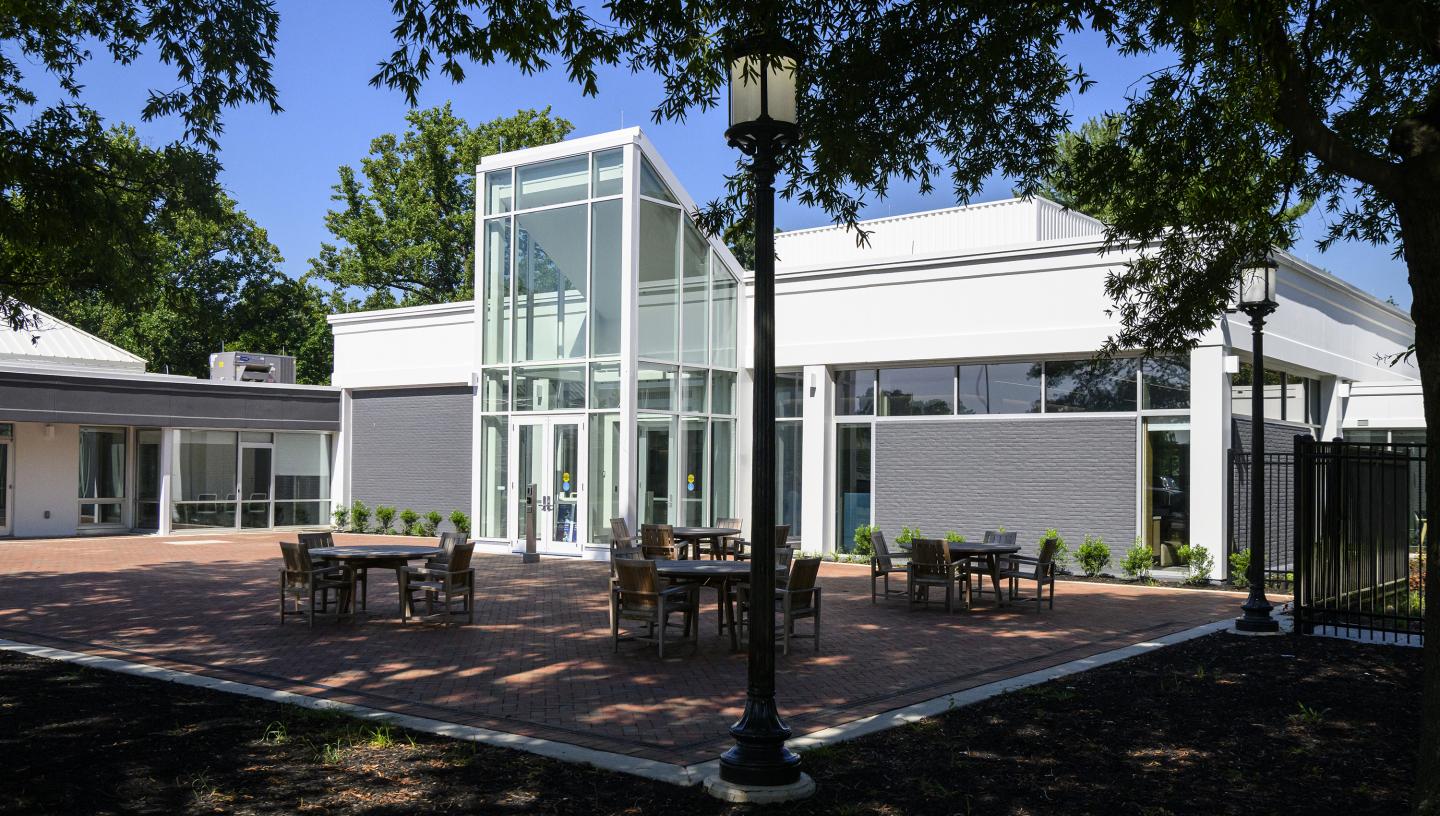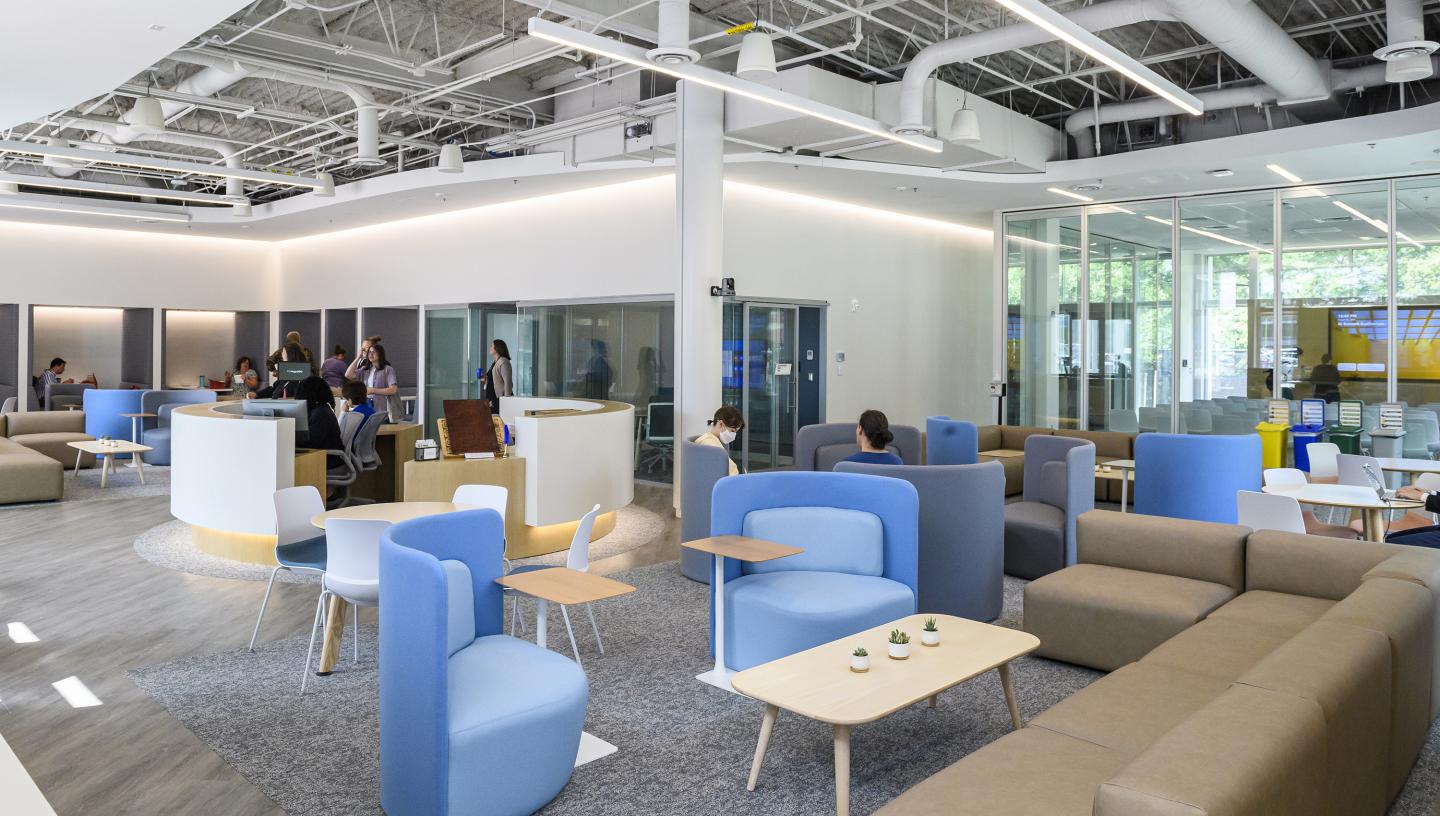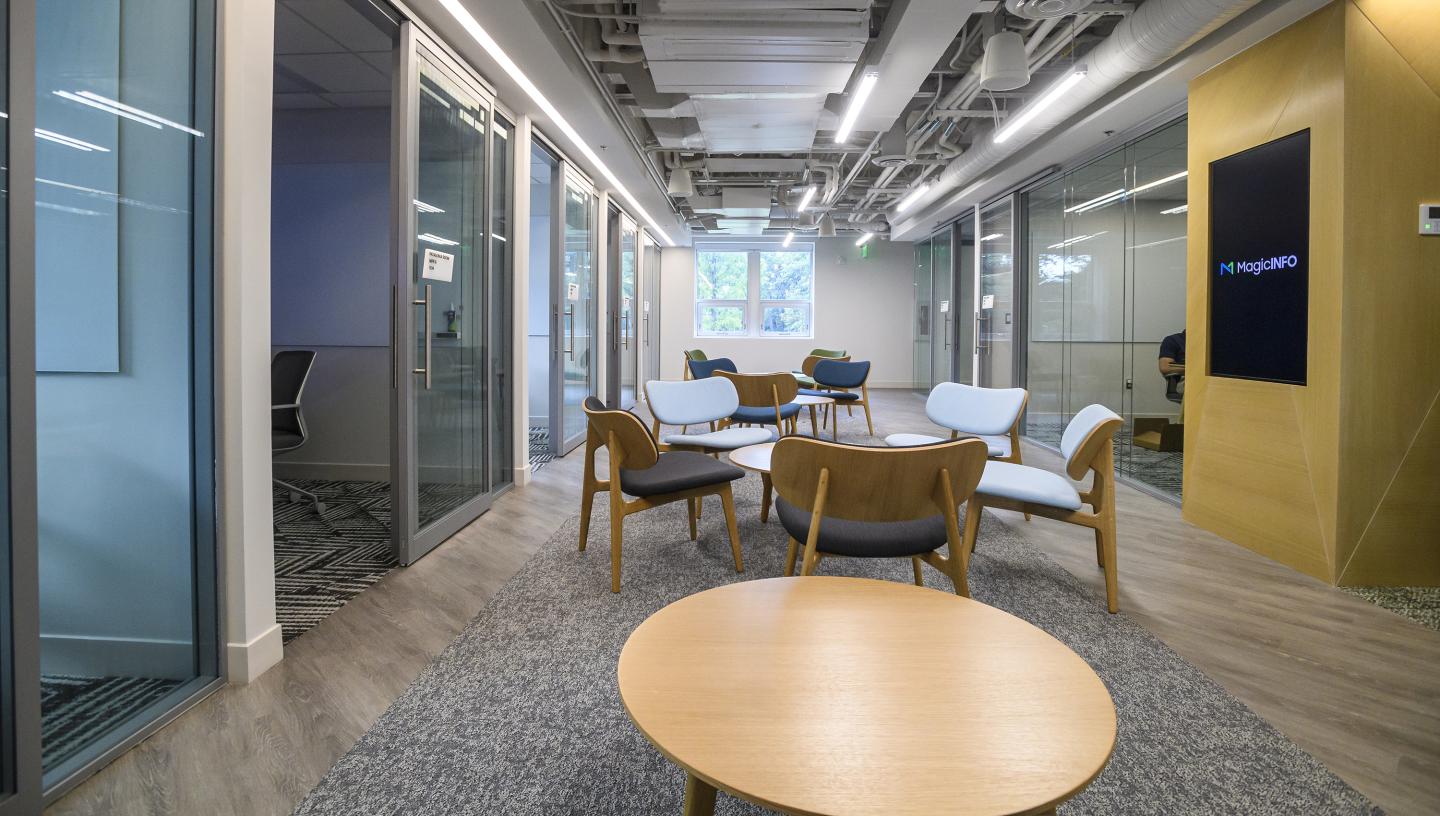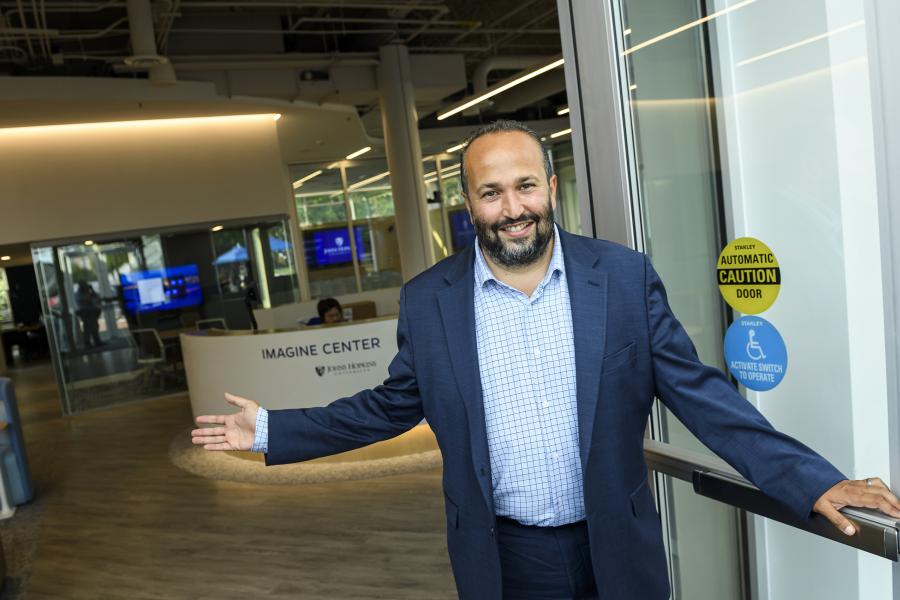Since 2018, Johns Hopkins has been quietly revolutionizing its approach to student career and life design. Now, the revolution has a headquarters.
The Imagine Center for Integrative Learning and Life Design, located on the northern perimeter of the university's Homewood campus, is home to seven student-serving offices and is the nerve center of the universitywide Division of Integrative Learning and Life Design. The building, formerly home to the U.S. Lacrosse Hall of Fame, has been renovated and redesigned to reflect the university's forward-thinking approach to integrative and experiential learning, mentoring, and professional development.
"The Imagine Center is really a physical manifestation of the culture change we started at Johns Hopkins four years ago," says Farouk Dey, vice provost for integrative learning and life design. Dey, who joined Hopkins in 2018, has been the architect of that change, moving away from outdated models of career services to the philosophy of life design, which refutes the notion that fulfilling careers are the result of incremental steps in a carefully planned path. Rather, life design posits that fulfilling careers happen as a result of exploration and experimentation—pursuing curiosity and taking chances on immersive experiences such as research, internships on and off campus, and study abroad opportunities to find those things that inspire and engage us.
The university has realigned 11 pre-existing offices at Hopkins under the integrative learning and life design approach and has created four new departments to better serve students and alumni. The 15 offices that now fall under integrative learning and life design are dedicated to providing opportunities for hands-on, experiential learning, as well as opportunities for students to build meaningful professional and academic connections through mentorship. Dey's vision of life design now pervades the university, with life design offices and resources on every academic campus.

Image caption: The building is located on the northern edge of the university's Homewood campus in what used to be the U.S. Lacrosse Hall of Fame.
Image credit: Will Kirk / Johns Hopkins University
The Imagine Center, where the integrative learning and life design offices will be based on Homewood, houses the Life Design Lab (formerly the Homewood Career Center), where specialists partner with academic programs to educate students on life design principles and to help them find programs where they can experiment or pursue new interests. It also houses University Experiential Learning, which handles on-campus jobs and internships, and the Hopkins Office of Undergraduate Research (HOUR), which helps facilitate on-campus student research opportunities. The building is also home to PHutures, which handles professional development and life design for PhD students and postdoctoral fellows; the Global Education Office, or GEO (formerly the Office of Study Abroad); Hire Hopkins, a hub for employer recruitment; and Hopkins Connect, the university's home for alumni mentorship.
But notably, none of these departments will actually have offices in the building. Further bucking the trends of higher education, Dey envisioned a building without individual offices, where staff and faculty intermingle with the students they serve. On the building's main level, educators and students can co-work comfortably in a suite of cocoon-like chairs, plush couches, and deep, pub-style booths in the building's main atrium. There is a small auditorium with retractable glass walls to accommodate audiences of different sizes for talks, presentations, and conferences. There is a large staff conference room, as well as a bank of private telephone rooms for phone and video-conferencing calls. In another wing of the building's main level, a cluster of smaller conference rooms are available to educators, students, alumni, and employers as co-working spaces or mentoring and interview rooms. There is a central café, a lactation room, and Homewood campus's first purposely built, all-gender restrooms that include fully enclosed toilet stalls, centrally located lavatories, and an adjacent ADA compliant family-style restroom.

Image caption: On the building's main level, educators and students can co-work comfortably in a suite of cocoon-like chairs, plush couches, and deep, pub-style booths in the building's main atrium.
Image credit: Will Kirk / Johns Hopkins University
The main floor of the building will also feature a content creation lab, filled with equipment to create videos, reels, and other content for platforms like TikTok, YouTube, and Instagram. Dey hopes the lab will attract and support the needs of future content creators and thought leaders—including those employed by the university.
It was an unconventional decision, Dey says, to remove all personal offices. "While it was initially met with mixed reactions, the decision helped us focus the newly designed culture and space on what matters the most: student and alumni success," he says. "The pandemic has helped everyone think in new ways about the evolving purpose and use of space on college campuses."
For Clifton Shambry Jr., associate director of life design: diversity and inclusion, the office-less layout of the building will facilitate the kind of accessible guidance he provides to students as a life design educator.

Image caption: A bank of small conference rooms is available to educators, students, alumni, and employers as co-working spaces or mentoring and interview rooms.
Image credit: Will Kirk / Johns Hopkins University
"Gen Z is looking for spaces where they can be themselves, and they are specifically not interested in spaces where they can't be themselves," Shambry says. "Our vision of life design is that it's not just a transaction, it's a transformation of the student's experience. It's caring about the student's whole being and providing them with opportunities to explore and to connect with others."
For Roshni Rao, executive director of Phutures, the Imagine Center is already a gathering space for PhD students, postdocs, employers, and educators.
"In the past, we were flitting around campus, meeting the students here and there," Rao says. "But the Imagine Center has become, in a short amount of time, a place where everyone is flocking. We meet here, we've had a birthday celebration here, we're planning to host the hybrid Horizons at Hopkins Conference here. There's just a great buzz and vibe in the building now."
To accommodate the needs of team members who require quieter and more private space to work, the building's two lower levels now house a staff-only workspace and a fully equipped living space with a lounge, kitchen, lockers, an all-gender restroom, and a shower. The communal design of these dedicated staff areas means that employees who formerly worked in different departments and offices now sit together, increasing the odds that they also experience those chance encounters that inspire new ideas and innovative thinking. "In a post-pandemic work era, this flexible design helps our team members be excited about returning to campus while continuing to leverage virtual spaces" Dey says.
It was vital that the building's design matched life design's mission for experimentation and engagement, Dey says. Even down to the names of the rooms—the Serengeti, the Matterhorn, the Patagonia, the Denali—and the graphic accent walls with murals of forests and soaring mountaintops, all of which are meant to evoke adventure and risk-taking.
This level of attention to detail might not have been effective if Dey's vision and strategy weren't proven to work. In the four years since joining Hopkins, he and his team have vastly improved student engagement with career and life design. In a biannual survey of seniors, satisfaction with career services/life design grew from just 37% in 2016 to 68% in 2022. Student engagement with life design—which is tracked daily based on students' interactions with programs, resources, and services—hovers at around 73%, up from 35% in 2019.

Image caption: The Imagine Center auditorium is a flexible space that can accommodate audiences of different sizes for talks, presentations, conferences, or social events.
Image credit: Will Kirk / Johns Hopkins University
More students are taking part in immersive experiences, too. In just five years, the Hopkins Office of Undergraduate Research has increased how many students it engages from 40 to 3,500. Total funding for undergraduate research increased from $200,000 to $1.67 million. And more students are working with alumni mentors than ever before—nearly 6,000 mentors spent this past summer working with more than 11,600 current students.
About 98% of the graduating Class of 2021 participated in some form of life design immersive experience—study abroad, research under a faculty member, on-campus employment, or a mentorship or internship, for example—during their time at Hopkins.
"Johns Hopkins students are remarkable for their curiosity, creativity, and desire to make a lasting impact on our world," said university President Ron Daniels. "As an institution devoted to education and research, it is our privilege and responsibility to help them unleash their potential—while they are here and in the years ahead. I am thrilled to be able to deliver on this promise to our students through our life-design programming, the ethos of which is now so perfectly embodied in the Imagine Center, and so grateful to Farouk Dey and the wonderful staff who are making this vision a reality."
Added Provost Sunil Kumar: "We were thrilled to launch the Imagine Center this semester as a hub for students to connect with each other and learn more about the immersive experiences and experiential learning opportunities that the university provides. We strongly believe in the life design vision Farouk is building across the university, and the data shows that we are on the right track."

Image caption: The Imagine Center's two lower levels include a living space with a lounge, kitchen, lockers, an all-gender restroom, and a shower. There is also a co-working space with desks where staff members from different departments can collaborate.
Image credit: Will Kirk / Johns Hopkins University
These engagement numbers are especially notable as Johns Hopkins increases the racial and economic diversity of its student body. As more students from diverse backgrounds enroll at Hopkins, more also receive opportunities to take part in academic and co-curricular activities that engage and inspire them. And the integrative learning and life design team is increasing the funding for these students' experiential learning, which grew from $53,400 supporting 33 students in 2017 to $520,944 supporting 247 students in 2022. Dey's goal is to increase funding for summer programs to $1 million in order to make immersive experiences more attainable for students for whom cost might be a barrier to participation.
"Our model is to simply integrate work skills development required for them to succeed in the future of work, the immersive experiences necessary for their professional growth, and the connections with mentors and employers to advance in their careers. When this process isn't engineered on a college campus, it is fragmented and happens by chance, which diminishes equitable outcomes for students," Dey says. "It's not enough that fewer students are slipping through the cracks. Every one of our graduates deserves a chance to design a fulfilling life and career, regardless of background or social capital."
Though these services are especially important for undergraduates, many of whom are at the start of their academic and professional careers, the life design team is also highly attuned to the needs of graduate students and postdoctoral fellows. Even those who are more advanced in their career paths can benefit from the principles of life design, says Rao, who works with PhDs and postdocs. "Through life design, we're trying to help students, even those who are five, six, seven years into their doctoral education, to realize where their inner compass is pointed," she sayd. "Through this culture change, what we are telling our students—even those further along in their journeys—is that there are multiple pathways to a meaningful career. Life design helps them discover that."
Which comes back to the design of the Imagine Center. There are no office hours, no waiting rooms, no intimidating hallways to get lost in. "We're removing barriers, literally and figuratively," Dey says. "We are making it possible for all students and alumni to imagine possibilities, experiment with curiosity, build lifelong skills and relationships, and design fulfilling lives."
He says the progress his team has made wouldn't be possible without the support and buy-in from the university administration. "Coloring outside the lines challenges norms and order, but Johns Hopkins embraces unconventional ideas" Dey says. "I am grateful to President Ron Daniels, Provost Sunil Kumar, our campus partners, and our talented team for celebrating and elevating the outside-the-box thinking."
The Imagine Center for Integrative Learning and Life Design is open from 8:30 a.m. to 8 p.m. Monday through Friday and from 10 a.m. to 6 p.m. on Saturdays. A ribbon-cutting celebration is planned for later in the fall semester. Students, alumni, and campus partners are invited to visit the Imagine Center, browse through its new website, get to know the integrative learning and life design team, and dream up their next big adventure. Dey wouldn't have it any other way.








